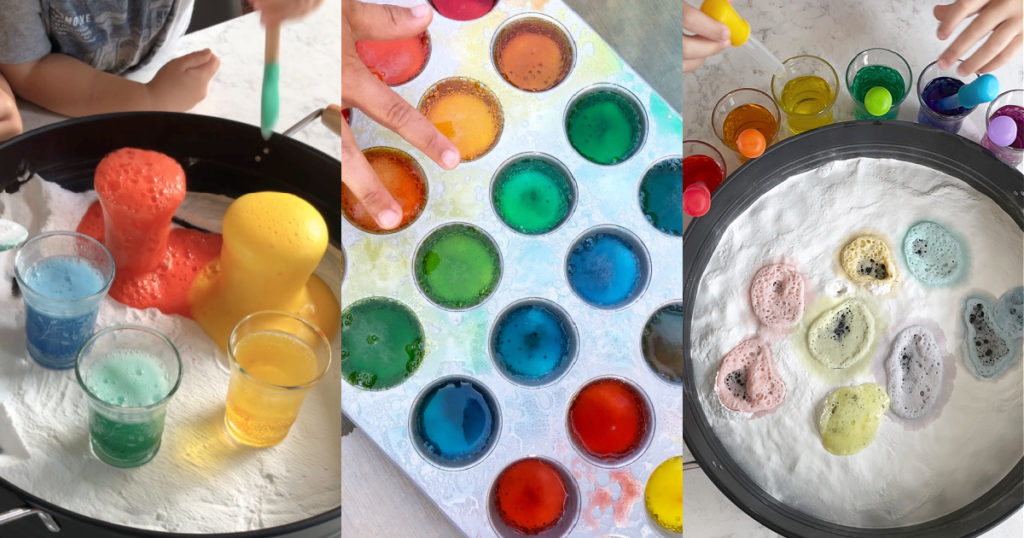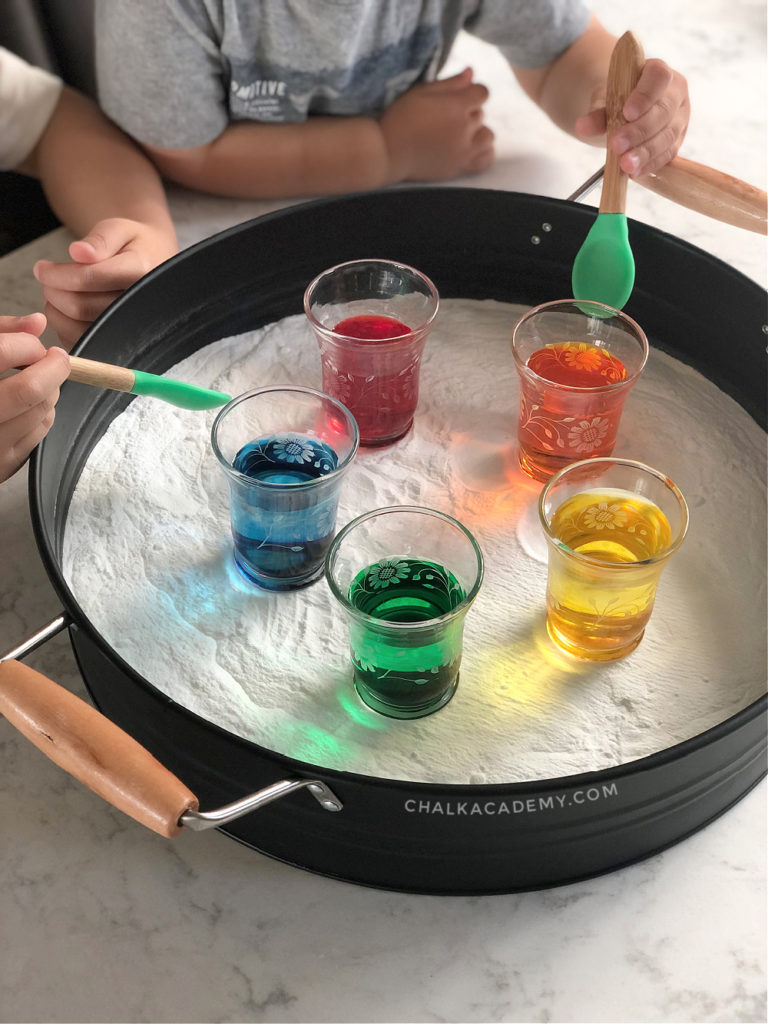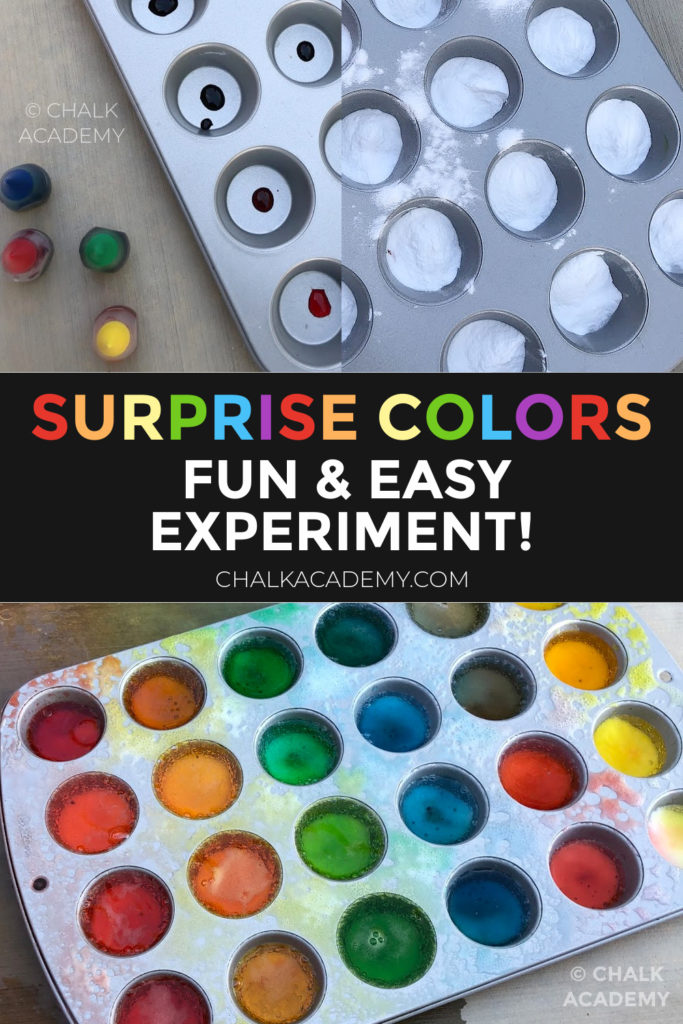Baking Soda and Vinegar Science Experiments: Color Explosion for Kids!

Over the years, our kids have enjoyed dozens of baking soda and vinegar experiments! We regularly use baking soda and vinegar for cleaning, and my kids love these ingredients for special science fun. Color explosions are definitely among their favorite hands-on activities!

Chalk Academy is reader-supported. Some of the links are affiliate links. When you buy something through an affiliate link, we may earn a very small commission at no cost to you. Details here.
Since we’re raising bilingual children, we try to make our non-dominant language, Chinese, as fun as possible. I’ve shared before about how new experiences are the key to making the minority language memorable. During these baking soda and vinegar experiments, try to encourage the minority language while your child is excited and interested!
I’ll share the basic science behind this baking soda and vinegar reaction, relevant Chinese translations, and 4 of my kids’ favorite versions of this activity!

The science behind baking soda and vinegar experiments
Recommended materials
The main chemical ingredients
- Baking soda 小苏打 / 小蘇打 (xiǎo sūdǎ) or 苏打粉 / 蘇打粉 (sūdǎ fěn)
- Please note that this is different than baking powder 泡打粉 (pāo dǎfěn) or 发酵粉 / 發酵粉 (fāxiào fěn)
- White vinegar 白醋 (báicù)
Supplemental supplies
- Food coloring 食用色素 (shíyòng sèsù)
- Pipette 滴管 (dī guǎn)
- Containers 容器 (róngqì): Cups 杯子 (bēizi), bottles 瓶子 (píngzi), or shot glasses 酒杯 (jiǔbēi)
- Flat pan 平底锅 / 平底鍋 (píngdǐ guō)
- Digital pH scale or paper pH strips
Baking soda and vinegar chemical reaction
Chemical reactions occur when 2 molecules interact to form new compounds or molecules. If you’re wondering if a chemical reaction is happening, look for changes in:
- Color
- Odor
- Temperature
- State of matter (eg, formation of gas [bubbles] or solid [precipitate])
In this activity, baking soda (eg, sodium bicarbonate, NaHCO₃) is interacting with vinegar (eg, combination of water [H2O] and acetic acid [CH₃COOH].
Before adding food coloring, I suggest exploring the properties of baking soda and vinegar alone!
For older kids who are learning about acids and bases, you can use pH strips to compare baking soda and vinegar. Acids have a proton (hydrogen ion, H+) that they want to get rid, while bases want protons.
When baking soda (solid 固体, base 碱) dissolves in vinegar (liquid 液体, acid 酸), protons are being exchanged. During the chemical reaction, carbon dioxide gas is released, causing visible bubbles and audible fizzing! Water is also left behind, which is why the leftover liquid doesn’t keep bubbling when the reaction is over.
If you’re curious about the chemical equation, check out this article from Thought Co! Also check out Thomas Gray’s Elements Trilogy (3-book series) to learn about elements, molecules, and reactions with your kids!

Questions to explore during baking soda and vinegar experiments
Factors that increase chemical reaction rates
- Concentration
- Temperature
- Pressure
- Mixing
How much baking soda and vinegar do you need?
I think this question in and of itself would be great to explore with your kids rather than me giving the answer we discovered! 🙂
Explore different volumes of vinegar and baking soda to see how the concentration affects the reaction!
Should you add baking soda or vinegar first?
We have experimented with pouring baking soda into vinegar as well as vinegar into baking soda. Again, this would be a great experiment to try with your kids so that your family can compare the reactions!
We found that pouring vinegar into baking soda results in instant bubbling and fizzing, while the reverse took a little longer. Why did this happen? The pressure and speed of the liquid vinegar hitting the baking soda accelerated the chemical reaction. On the other hand, the lightweight baking soda reached the liquid vinegar at a lower speed and pressure.
Other scientific questions
- Does the temperature of the vinegar affect the reaction?
- Does stale versus fresh baking soda affect the reaction?
- What is the pH of each food dye, and how does it affect the reaction?

Science activity vocabulary in Chinese and English
For parents like me who are learning Chinese with their kids, here are key words and phrases in simplified Chinese, traditional Chinese, Hanyu Pinyin, and English.
If you have younger kids, focus on common verbs (guess, pour, explode), adjectives (color, wet, dry), and nouns (eg names of materials). For older and/or more fluent kids, introduce science terms with the activity.
Important words/phrases
- Solid 固体 / 固體 (gùtǐ)
- Liquid 液体 / 液體 (yètǐ)
- Gas 气体 / 氣體(qìtǐ)
- States of matter 物质状态 / 物質狀態 (wùzhí zhuàngtài)
- Physical form 物质形态 / 物質形態 (wùzhí xíngtài)
- Chemical reaction 化学反应 / 化學反應 (huàxué fǎnyìng)
- Color explosion 颜色爆炸 / 顏色爆炸 (yánsè bàozhà)
Important sentences
- Today, we’re going to do an experiment! 今天,我们要做一个实验! / 今天,我們要做一個實驗!(Jīntiān, wǒmen yào zuò yīgè shíyàn!)
- We need these materials. 我们需要这些材料。/ 我們需要這些材料 。(Wǒmen xūyào zhèxiē cáiliào.)
- Can you guess what will happen? 你能猜会发生什么吗?/ 你能猜會發生什麼嗎? (Nǐ néng cāi huì fāshēng shénme ma?)
- Baking soda is a solid. 小苏打是固体。 / 小蘇打是固體。(Xiǎo sūdǎ shì gùtǐ.)
- Pour the baking soda here. 小苏打应该倒在这里。 / 小蘇打應該倒在這裡。(Xiǎo sūdǎ yīnggāi dǎo zài zhèlǐ.)
- Vinegar is a liquid. 醋是液体。 / 醋是液體。 (Cù shì yètǐ.)
- Pour the vinegar here. 醋要倒在这里。/ 醋要倒在這裡。(Cù yào dào zài zhèlǐ.)
- It’s okay if you spilled. 如果你洒了, 没关系。/ 如果你灑了,沒關係。(Rúguǒ nǐ sǎle, méiguānxì.)
- Please use this towel to wipe the table. 请用这条毛巾擦桌子。/ 請用這條毛巾擦桌子。(Qǐng yòng zhè tiáo máojīn cā zhuōzi.)
- Try it again. 再试一次。/ 再試一次。(Zài shì yīcì.)
- This color is _________. 这个颜色是_________。/ 這個顏色是_。(Zhège yánsè shì_________.)
- Red 红色 / 紅色 (hóngsè)
- Orange 橙色 (chéngsè)
- Yellow 黄色 / 黃色 (huángsè)
- Green 绿色 / 綠色 (lǜsè)
- Blue 蓝色 / 藍色 (lánsè)
- Purple 紫色 (zǐsè)
- Pink 粉红色 / 粉紅色 (fěnhóng sè)
- Brown 棕色 (zōngsè)
- Black 黑色 (hēisè)
- White 白色 (báisè)
- Wow! So cool! 哇! 非常酷!(Wa! Fēicháng kù!)
- It’s bubbling! 冒泡了! (Mào pàole!)
- Hear the fizzing sound? 听到嘶嘶声吗?/ 聽到嘶嘶聲嗎?(Tīng dào sī sī shēng ma?)
- It formed a gas. 它变成了气体。/ 它變成了氣體。 (Tā biàn chéngle qìtǐ.)
- This color explosion is a chemical reaction! 这种颜色爆炸是化学反应!/ 這種顏色爆炸是化學反應! (Zhè zhǒng yánsè bàozhà shì huàxué fǎnyìng!)
- This is fun! 这个很有趣!/ 這個很有趣!(Zhège hěn yǒuqù!)
- Let’s do this again! 让我们再做一次! / 讓我們再做一次! (Ràng wǒmen zài zuò yīcì!)
Try this: Positive Affirmations to Tell Our Kids Everyday (English / Chinese Printable)
4 fun baking soda and vinegar color activities for kids!
Here are 4 favorite ways that we have explored baking soda and vinegar with a color explosion twist! Adult supervision required.

Bubbly rainbow fountains!
Steps:
- First, pour vinegar into small cups. 首先,把醋倒进小杯子里。/ 首先,把醋倒進小杯子裡。(Shǒuxiān, bǎ cù dào jìn xiǎo bēizi lǐ.)
- Add a few drops of food coloring. 加几滴食用色素。/ 加幾滴食用色素。 (Jiā jǐ dī shíyòng sèsù.)
- Pour baking soda into a flat pan. 把小苏打倒进平底锅里。/ 把小蘇打倒進平底鍋裡。 (Bǎ xiǎo sū dǎdǎo jìn píngdǐ guō lǐ.)
- Scoop baking soda into the cups. 把小苏打倒进醋里。/ 把小蘇打倒進醋裡。 (Bǎ xiǎo sū dǎdǎo jìn cù lǐ.)
The kids had fun watching the cups overflow if they scooped a “full spoon” of baking soda rather than a fraction of a spoon.

Although regular spoons were used in the above photo, measuring spoons would be a more scientific way to compare reactions!

Rainbow fizz!
Here’s another variation of the baking soda and vinegar reaction!
- First, pour baking soda into a flat pan. 首先,把小苏打倒进平底锅里。/ 首先,把小蘇打倒進平底鍋裡。 (Shǒuxiān, bǎ xiǎo sū dǎdǎo jìn píngdǐ guō lǐ.)
- Pour vinegar into small cups. 把醋倒进小杯子里。/ 把醋倒進小杯子裡。(Dào jìn xiǎo bēizi lǐ.)
- Add a few drops of food coloring. 加几滴食用色素。/ 加幾滴食用色素。 (Jiā jǐ dī shíyòng sèsù.)
- With pipettes, squirt vinegar into baking soda. 用滴管把醋滴进小苏打里。/ 用滴管把醋滴進小蘇打裡。(Yòng dī guǎn bǎ cù dī jìn xiǎo sūdǎ lǐ.)
This time, colored vinegar was squirted into the baking soda with pipettes. We noticed that the bubbling occurred instantly, no matter how much vinegar was added. Since the pipettes have numbers, we could compare number of milliliters and visible bubbling.

Bubbly blocks!
To experiment with temperature, we froze blocks of baking soda in an ice cube tray! Mix 1/2 cup of water and 1 cup of baking soda and divide equally in the ice cube tray. If you want to add food coloring, just add a few drops of the desired color to each cube!

Rainbow surprise!
Another favorite is this mystery colors spinoff that was inspired by various activity moms including Busy Toddler! As you can imagine, this is the messiest but most exciting version of the baking soda and science activity. My kids had fun squirting food coloring at the bottom of each muffin cup and hiding it with baking soda. Then the best part: squirt vinegar for fizzy color surprises!
Have you tried these fun baking soda and vinegar science experiments?
If you try these fun science activities, please let us know in the comments below! What age(s) are your kid(s) and how did it go? We’d love to hear about your learning experience!
AMAZING!! This helped me a lot with my science project. Thx for the ideas!
You’re welcome, Stephanie! So glad it was helpful!